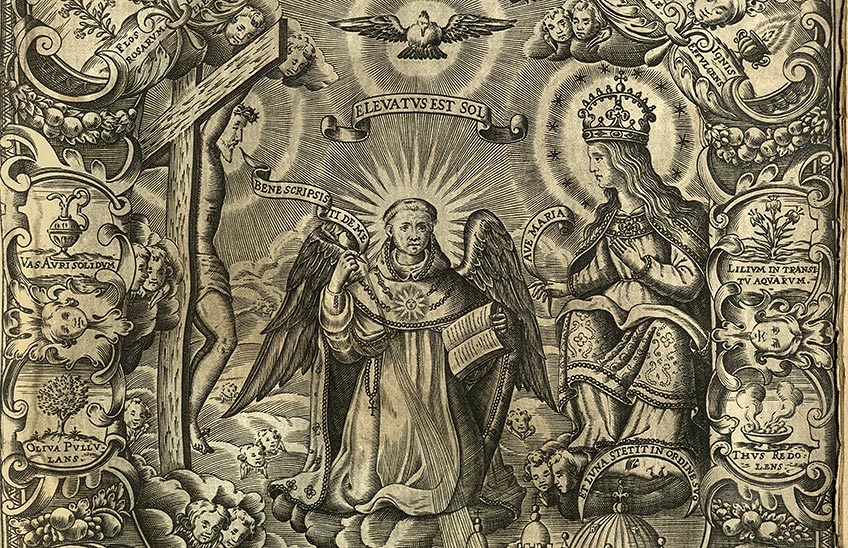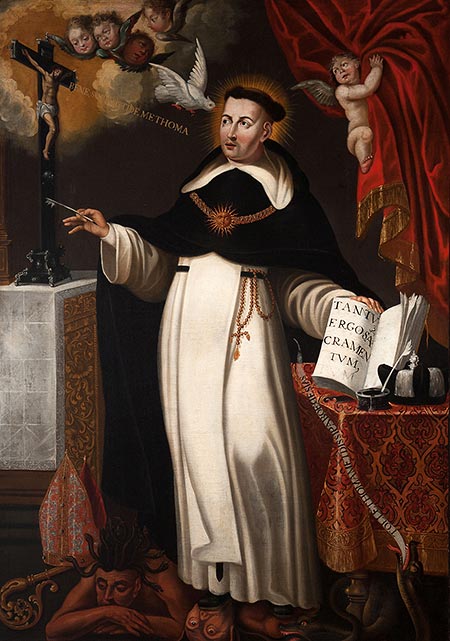The image of Saint Thomas Aquinas

FotoCedida/Grabado de santo Tomás de Aquino por Juan de Courbes, que ilustra el <i>Curso de Teología</i> de fray Juan de Santo Tomás (Alcalá, 1635)
The distinguished figure of Saint Thomas (†1274), having been one of the great personalities of Philosophy and theology, has a A interest in relation to the arts. This is borne out, on the one hand, by the fact that he theorised on beauty at the height of the Gothic period and, on the other, by his rich iconography.
St Thomas wrote at a time when cities were flourishing, when the foundations of modern culture were being laid, with the renewal of scientific, literary and philosophical knowledge being imparted by the thriving universities, which were becoming more and more powerful and broader in their outlook.
Aesthetics in Thomistic writings
Beauty, together with the captivation of those who contemplate artistic works, have been two important points in the creative process of works of art, which mentors and artists have taken very much into account. Successive historical periods have applied different parameters to beauty, aware that it is a quality present in the mind of human beings, which produces intense pleasure and stems from sensory manifestations. Plato included beauty alongside truth and goodness in the set of divine principles. Greek and Roman art advocated symmetry and proportion as standards of aesthetics and St. Augustine insisted on the principles of unity, issue, equality, proportion and order.
For St Thomas "Pulchra sunt quae visa placent" (beautiful are the things that please the sight), affirming that beautiful are those things whose perception, in its very contemplation, pleases: "Pulchrum est id cuius ipsa aprehensio placet", which is in relation to sight, as the most perfect sense that replaces the language of the rest of the senses.
Concretely, his aesthetic vision presents us with three principles. The first is "integritas" or perfection, because that which is deficient cannot be beautiful. What is deteriorated, or incomplete, is in itself ugly. The second is based on "consonantia" or proper proportion, order and moderation. It is about the proper harmony and relationship between the parts of the object itself but, above all, about the connection between the work and the perceiver. Finally, in third place, it refers to light-blueness or "claritas", a concept that would be replaced, centuries later, by that related to luxury and ostentation.
All these ideas fitted perfectly into the art manifestations of the leave Age average, when the concepts of "good and beauty" and "aesthetics of light" as divine reflection and immaterial sign are insistently repeated.
On the other hand, St Thomas, in dealing with eutrapelia, rediscovering Aristotle, elaborated a doctrine on the aforementioned virtue integrated into Christian ethics, by which he justified laughter and the delectation provided by sight, always in moderation. Like the smile of the Gothic virgins of the Île de France and that of the Good God of Amiens, his doctrine on amusement and distraction inaugurated, in perfect convergence, a new era of moral theology, although it would not be followed very closely by theologians of the rigorist tradition, except for Saint Francis de Sales, who expanded the Thomistic contents in the aforementioned subject.

Triumph of St. Thomas Aquinas in the Dominicans of Pamplona, by Vicente Berdusán, 1764
Read at core topic cultural and religious images
In 1323 he was canonised and later elevated to the rank of Doctor of the Church in 1567. He was usually described as Doctor angelicus, Scholarum princeps, Lumen Ecclesiae. In his numerous iconographies he was depicted in various passages of his life, both historical and in others with which various legends embellished his figure.
Its relationship with the arts is enhanced by its numerous representations from the leave Age average to the present day, by outstanding artists, in different historical periods and in different styles, including Filipino Lippi, Fra Angelico, Raphael, Pedro Berruguete, Velázquez and Zurbarán in his famous Apotheosis of the saint, destined for his Sevillian high school , in 1631.
Sculptures, paintings with his image, narrative cycles and above all triumphs have depicted him alone or among Aristotle, Plato, other philosophers, doctors, founders, apostles and saints. On other occasions, we find him defeating the heretics Arius and Sabellius, who, with Averroes, contested revealed truth. The Dominicans commissioned numerous triumphal allegories from painters "ad maioren ordinis Praedicatorum gloriam", and his figure became popular, not corpulent as he was in reality, but slimmed down and subjected to a process of idealisation.
He is easy to identify iconographically. He wears the habit of the Dominicans, which consists of a white tunic, long to the feet and fastened with a strap, a scapular of the same colour, a cape with a wide hood and a black coral cloak. As is well known, the habit, as well as being a unifying element for those who wear it within a community, also identifies, to a large extent, its spiritual ideals, which are generally related to its origin, to the people who founded each order and to the rules that govern them. In the case of the Dominicans, their charism is defined by the study of truth, the university, the Philosophy, the combination of contemplative and apostolic life, preaching and profound prayer.
Among the attributes characteristic of Saint Thomas Aquinas are the book and the pen, the model of a church, the sun, the rosary and the wings, accompanied on numerous occasions by the Dove of the Paraclete. The book - usually open - and the pen speak of his tireless writing, his wisdom and the revealed doctrine, the fruit of his intelligence and tenacity. The revelation is signified by the presence of the dove of the Holy Spirit. His chest is usually adorned with a sun supported by a rich necklace, alluding to the fact that with his doctrine he enlightens everyone, in the same way that the sun, with its rays, gives light to the whole earth. The sun, from early times, possessed a divine character and together with the saint of Aquino its universal light was parallel to the doctrine of wisdom and truth of his doctrine.
The rosary is typical of the Dominican order for having contributed to its dissemination and to the cult of the Virgin of the Rosary. The model alludes to his status as a doctor of the Church, as it is an attribute of founders and doctors. Finally, the wings make reference letter to his status as an angelic doctor and to his possession of the same qualities as the angels: intelligence, wisdom and purity.

Canvas of Saint Thomas Aquinas, author of the official document of Corpus Christi, in the parish church of San Pedro de la Rúa in Estella, third quarter of the 17th century.
To find out more
RÉAU, L., Iconography of Christian Art. Iconografía de los santos, t. 2, vol. 5, Barcelona, El Serbal, 1998, pp. 281-285.
PÉREZ SANTAMARÍA, A., "Aproximación a la iconografía y simbología de Santo Tomás de Aquino", Cuadernos de Arte e Iconografía, no. 5 (1990), pp. 31-54.
MATILLA, J.M., La estampa en el libro barroco. Juan de Courbes, Vitoria, Ephialte, 1991, pp. 137-138.
